Gerry Adams's Blog, page 33
February 8, 2019
Then they came for …You

Gaza City
Two weeks ago a Bill banning the import of goods made on illegal Israeli settlements on Palestinian land was overwhelming passed in its second reading by the Dáil – 78 votes to 45 votes. It was an important vote. The ‘Control of Economic Activity Occupied Territories Bill’, which was introduced by Seanadóir Frances Black, successfully passed all stages in the Seanad in December. To become law it must now go through a similar process of votes and scrutiny and possible amendment in the Dáil.
The Bill, which was debated on Wednesday, and passed its second stage on Thursday, does not specifically reference Israel and its occupation of Palestinian land. If it completes it passage through the Dáil it will be an offence to import or sell goods or services from occupied territories anywhere in the world. Inevitably however, much of the focus in the Seanad and in the Dáil has been on its impact on goods and services originating in illegal Israeli settlements in the West Bank.In its response the Israeli government called in the Irish Ambassador to protest at the passing by the Dáil of the Bill – even though Simon Coveney, the Fine Gael Minister for Foreign Affairs, clearly stated in his Dáil contribution his government’s intention of blocking the legislation from passing into law. Israel warned that banning imports from the west Bank would result in “severe ramifications.” Last year it threatened to close its Embassy in Dublin over the introduction of the Bill. The Israeli government also claimed that the Bill is “hypocritical and anti-Semitic”. On that basis those many Israeli citizens who oppose Israeli Prime Minister Benyamin Netanyahu’s settlement policies in the west Bank could be similarly accused of anti-Semitism.
The Occupied Territories Bill is about upholding and respecting international law. It’s about challenging those states which abuse and exploit their illegal occupation of territory that belong to others.
The debate in the Dáil also saw a renewed focus on efforts to get the Irish government to honour its Programme for Government commitment, and the democratic vote of both Houses of the Oireachtas in 2014, to recognise the state of Palestine. The government’s stance on this has been reprehensible and shameful.As the government has stalled and prevaricated, the daily slaughter and oppression of Palestinians has continued. Two weeks ago the Israeli human rights group B’Tselem revealed that 290 Palestinians were killed by Israeli forces in 2018. 55 of these were children. Ten years ago this month Israeli forces invaded the Gaza Strip. That one sided massacre resulted in 13 dead on the Israeli side, and one thousand four hundred and seventeen dead Palestinians. Among them three hundred and thirteen children.
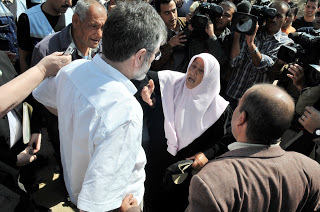 I visited Israel and the Gaza strip not long after that first assault. I was horrified by the scale of the human tragedy. The UN report in to the 2009 invasion concluded that it was a deliberate disproportionate attack by Israel designed to punish, humiliate and terrorise a civilian population.
I visited Israel and the Gaza strip not long after that first assault. I was horrified by the scale of the human tragedy. The UN report in to the 2009 invasion concluded that it was a deliberate disproportionate attack by Israel designed to punish, humiliate and terrorise a civilian population.The Israeli occupation of Palestinian lands; the so-called separation wall; the theft of water rights and of land for illegal settlements, have all been well documented. There are approximately 650,000 Israeli settlers living in 143 locations in the West Bank (132) East Jerusalem (11). There are also 106 “outposts” which are not formally recognized by Israel as settlements but which are tolerated by the government. Illegal Israeli settlements are not restricted to residential buildings. Israel has also constructed industrial and agricultural settlements. These sustain the settlement programme and many of their products are for export.
As a result of this settlement/colonial expansion the Palestinian economy is undermined; Palestinians are unable to access their natural resources, farmers are barred from their fields; and Palestinian homes are demolished and their crops, especially their olive groves, destroyed.
Last week a confidential report by EU diplomats in the Middle East was published by EUObserver. The 20-page report, which was compiled last summer, is intended to “inform Middle East policy” among EU Governments. It describes Palestinians in the west Bank as facing “systematic legal discrimination”. Alon Liel, a former Israeli diplomat and Ambassador to South Africa between 19992-94 told EU Observer that what Israel is doing to Palestinians is what apartheid South Africa did to black citizens. Liel, who I met in Jerusalem in 2014, said: “The west Bank legal regime is a form of institutionalised racial segregation. A simpler description would be apartheid”.
Israel is a first world, nuclear armed, economic power. The west Bank and the Gaza Strip is a third world region, impoverished and oppressed, with a society and economy entirely dependent on the generosity of others.
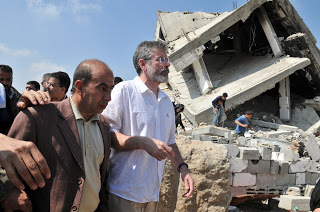
The reality is that it is the Israeli government which snubs diplomacy; rejects international criticism, has no interest in peaceful alternatives; and does not see armed force as a measure of last resort. Brute military force is Israel’s measure of first resort.
The Irish government’s excuses for opposing the Occupied Territories Bill are threadbare. Minister Coveney expects the Irish people to shamefully accept that Irish recognition of a Palestinian state must wait until there is a negotiated solution in the region. This hands the Israeli government a permanent veto over the rights of the Palestinian people.
The Minister further claims that the Bill is illegal under EU law. Seanadóir Frances Black has produced clear legal evidence in support of the right of the Irish government to impose individual restrictions on settlement goods. But the government refuses to test or challenge its interpretation of EU regulations.
In his remarks to the Dáil Minister Coveney restated the government’s determination to block the Bill. He said that if the government “adopts this Bill, we would be choosing to be a principled voice in the wilderness, satisfied in the righteousness of our course, but largely unable to influence the real action”.Better to be a principled voice in the wilderness speaking against injustice than to turn our backs on the multiple abuses being suffered by the Palestinian people. Pastor Martin Niemoller, a vocal critic of Nazism once warned against refusing to challenge injustice.
He wrote:First they came for the socialists, and I did not speak out—because I was not a socialist.Then they came for the trade unionists, and I did not speak out— because I was not a trade unionist.Then they came for the Jews, and I did not speak out—because I was not a Jew.Then they came for me—and there was no one left to speak for me.
Two weeks ago the centenary of An Chéad Dáil was celebrated by a joint sitting of the Dáil and the Seanad in the Mansion House. The meeting of the First Dáil was an illegal act. If we follow the rationale of Simon Coveney, and this government, then those who assembled on that occasion would not have done anything. Women still would not have a vote. Slavery would still be legal. No one anywhere in the world would have won a single right if we followed Minister Coveney’s rationale. If we, as a former colony still partitioned, still occupied in part by a Government we do not want, with our proud history of freedom struggle and resistance and our peace process, do not support the people of Palestine, then who will? There is no wrong time to do the right thing. The Government should support the Occupied Territories Bill.
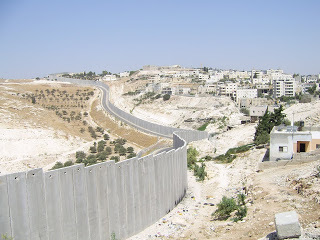 The Separation Wall
The Separation Wall
Published on February 08, 2019 02:11
February 1, 2019
48 hours in New York
Today marks 25 years since I was first given a visa by President Clinton to visit the USA. The visa was for 48 hours and restricted to New York. The London Telegraph described the President’s decision as having created the “worst rift” in US-British relations since the Suez crisis in 1956. I was reminded of all of this when the British released classified government papers last December under the 20-30 year rule. The papers confirmed that the British counter-strategy was largely unchanged from the 1970s. Supported by the Irish government,the SDLP, Unionist Parties, the Catholic Hierarchy and unionist paramilitaries, British strategy was about marginalising republicans, minimising political progress and resisting the fundamental change necessary to address the causes of the conflict. It was also about resisting any efforts by international players to get involved in investigating the conflict and its consequences. The British insisted that the war was an internal matter for the British government. The international community was told - Stay Out.This was the challenge facing the Sinn Féin leadership as we sought to build alliances with others and advance our own peace strategy. It was our view that the Irish-American community presented us with our best chance of internationalising the issue of peace in Ireland. It had the most developed of our support groups, and within the Irish-American community there was a deep interest in Ireland and a genuine desire to see peace achieved. Irish America also had considerable influence, not just in politics but in the business world as well. In April 1992 a well-known Irish American John Dearie organised a forum on Irish issues in Manhattan for the democratic Presidential hopefuls, Jerry Brown and Bill Clinton. Asked by one of the panelists if he would appoint a peace envoy for the north Clinton said he would. Asked if he would authorise a visa for me and other Sinn Féiners to visit the USA. Clinton replied; “I would support a visa for Gerry Adams”. Clinton then went further and endorsed the MacBride principles. That was the beginning of the engagement between Irish America and the Clinton Administration. The British government opposed this new US political agenda. The day after Clinton was sworn in as President the British government told journalists in London that its priority was to have the envoy idea scrapped.The declassified files reveal the extent to which the British fought to maintain the status quo. The British Ambassador to Washington, Sir Robin Renwick, said that the North “was part of the UK’and “solutions to its problems could not be imposed from outside”. Renwick raised the issue directly with Clinton’s National Security Adviser, Tony Lake. He urged the administration ‘not to pursue the idea of a peace envoy’. In a briefing for Patrick Mayhew, the then British Secretary of State, an NIO official said that the advice of the Foreign Office and the Washington Embassy was that the British government should ‘continue to oppose a peace envoy or a US Ambassador in Dublin with an NI role’.An invitation from Bill Flynn’s National Committee on American Foreign Policy in January 1994 to the North’s political leaders to address a conference in New York created a new dynamic. Bill Flynn was part of ‘Americans for a New Irish Agenda’ and the Connolly House group of US politicians, business people and trade unionists who were advocating for a change of policy by President Clinton.They had already had had some success with the appointment of Jean Kennedy Smith as US Ambassador to Dublin. Ambassador Smith was Ted Kennedy’s sister. She developed a close relationship with Fr. Alex Reid – the Sagart - and together they supported President Clinton giving me a visa to travel to the USA.Jean Kennedy Smith, who Fr. Reid and I called An Speir Bhean – the spirit woman - asked the Taoiseach Albert Reynolds what he thought of the US giving me a visa. Reynolds said he had no objections. She also asked John Hume who also said he had no objections. She herself expressed her support to her brother Ted Kennedy and to the White House. On January 14th 1994 I applied for a visa to attend the conference organised for February 1st. The British government began an intense private and public campaign to keep me out. The British Ambassador in Washington worked round the clock arguing that a visa for me would be a diplomatic catastrophe. They sought and received the support of the Congressional House Speaker Tom Foley, the Secretary of State Warren Christopher, the Attorney General Janet Reno and the Head of the FBI Louis Freeh. Tom Foley, later told me he made a mistake.On the other side Ted Kennedy and three Democratic Senate colleagues, Chris Dodd, John Kerry and Daniel Moynihan wrote to President Clinton backing the visa. Others in Irish America rallied to the issue. In addition full-page advertisements appeared in the New York Times calling for US support for efforts to find peace. The advertisement was signed by the Chairs or CEOs of 85 leading American corporations and over 100 other prominent Irish Americans. On January 30th President Clinton told his staff he was going to authorise the visa. It was to be a restricted visa for two days only and I had to remain within New York. The next morning, Monday I picked my visa up at the US Embassy in Dublin before just managing to get the midday Aer Lingus flight to New York. The British media and political establishment went wild in their condemnations. UUP MP Ken Maginnis said, “In the future deaths in Northern Ireland will be Clinton deaths”. The Daily Star commented that it would love to see me in a coffin with a gap where my face used to be. The Sunday Times referred to ‘gullible Americans’. Renwick told CNN, “When I listen to Gerry Adams I think, as we all do, it’s reminiscent of Dr. Goebbels’ – Hitler’s propaganda chief”.The 48 hour visit to New York was a blur of interviews, meetings with Irish America, speaking at the Bill Flynn organised conference, which the unionist refused to attend, and a huge public meeting in the Sheraton hotel with an exuberant crowd of Irish Americans. US journalists were genuinely astounded when they discovered that my voice could not be broadcast on the British media. The decision by President Clinton against the advice of some in his own administration and the strong objections of the British government, to grant the visa, was a huge step forward for the efforts to build peace.In itself the New York visa was a symbolic initiative but it broke the wall that British governments had built around the North to keep everyone else out.It was the beginning of a process that saw the negotiations process increasingly rely on international figures. People like George Mitchell, Harri Holkerri and John De Chastelain were just some of these. The Irish in the USA still have a crucial role to play in support of peace and unity in Ireland. The McGuinness Principles campaign in support of a rights agenda in the North is one example of that. Twenty Five years on last weeks Beyond Brexit – The Future of Ireland conference in Belfast will have been noted by policy makers in Washington. The struggle continues. Here and in North America.
Published on February 01, 2019 10:00
January 25, 2019
We don’t want no border at all
The chaos surrounding Brexit reached new depths of confusion this week. Theresa May’s Plan B announced on Monday turned out to be no plan at all. She ruled out an extension of Article 50 and a second referendum. There was a lot of spin about talking to business, the devolved administrations, opposition parties and trade unions – all of whose views she ignored for the last two and half years. With a straight face May told the British Parliament on Monday that she wants to find out what MPs are demanding on the backstop! And then she will take that demand back to the EU. The EU has already ruled out any renegotiation of the Withdrawal Agreement. At the time of writing– there are 65 days left to Brexit. It seems to me that May’s real plan is to talk the process down to the point where some MPs – frightened of the consequences of a no deal scenario – will change their vote and back her Withdrawal Agreement. She is playing for time.The consequences of this shambolic Tory government strategy for the two economies on this island, for social cohesion, and for the Good Friday Agreement are enormous. It demands the strongest, most robust, opposition. Sinn Féin, and especially our MEP team led by Martina Anderson, have led the defence of the Agreement. However, the greater onus to defend the rights of citizens in the North rests with the Irish government.The government’s initial response to Brexit, under a different Taoiseach, was like that of the Fianna Fáil leader, pathetic. It improved when Leo Varadkar and Simon Coveney as Taoiseach and Tánaiste. They presented a better all-island position but they avoided challenging the British Government or the EU to accept the democratic vote of the North to remain within the European Union. The Government has also acquiesced on the fundamental issue of the entitlement of Irish citizens in the North to European Union rights and the issue of rights generally.In December 2017 in the joint report produced by the EU and British Government, paragraph 52 specifically stated that the people of the North, "who are Irish citizens will continue to enjoy rights as EU citizens, including where they reside in Northern Ireland." The Taoiseach stated everyone born in the North "will continue to have the right to Irish and therefore EU citizenship." He also stated the joint report was rock solid, cast iron and politically bullet proof. In response to a letter signed by representatives of civic nationalism, the Taoiseach assured them the Government had protected their interests. He stated "Your birth right as Irish citizens, and therefore as EU citizens, will be protected". He added "You will never again be left behind by an Irish Government." It was a very welcome and positive commitment. However, many now believe this promise has been broken. The specific commitment to citizens who reside in the North is missing from the withdrawal agreement. I have raised this several times in the Dáil. The Government has yet to explain why the "rock-solid, cast iron" and "politically bullet proof" joint report commitment of December 2017 on the rights of Irish citizens in the North to enjoy rights as European Union citizens is missing from the withdrawal agreement. The additional seats allocated by the EU to this State could have been allocated to the North but the Government said "No." Why? In a letter to the Taoiseach last November, 1,000 civic nationalists from across the island of Ireland expressed their deep concerns at the Government’s commitment to uphold its promises and responsibilities under the Good Friday Agreement. They identified the denial of access to free healthcare in EU states and the prohibitive costs of students from the North studying at any university in the South. They said there is a real potential that partition could be reinforced and our country and our people further divided. The Irish Government and its lobby of EU neighbours on Brexit rightly stressed the centrality of the Good Friday Agreement to the outcome of the Brexit negotiations. Yet we have the Tánaiste and the Taoiseach repeatedly dismissing a part of the agreement, which is a referendum on Irish unity. That too is a key provision and an integral part of the Good Friday Agreement.At Queen's University two weeks ago the Tánaiste chose to claim that any debate on Irish unity would be like pouring petrol into a furnace that is already pretty hot. Once again, the Irish Government is limiting the rights of citizens to what is tolerable to a section of unionism. Has this led to unionist leaders being more friendly toward the Taoiseach and Tánaiste? No. The Tánaiste met the DUP recently. To the best of my recollection it is the first formal meeting the DUP leadership had with him since February last year despite numerous and appropriate efforts by the Government to meet them.The Taoiseach and the Tánaiste cannot cherry-pick from the Good Friday Agreement. There is a responsibility and a constitutional obligation to promote the goal of Irish unity and to work to achieve it through democratic dialogue and negotiation. The Taoiseach and Tánaiste also persist in blaming the impasse in the North on what they refer to as the problem parties of Sinn Féin and the DUP. While this may be popular with sections of Fine Gael support, it serves no purpose in the North, except to annoy nationalists and republicans. They will have been even more annoyed by the Tánaiste's ridiculous claim in the Dáil last Thursday that the British Government “has also recognised its own obligations under the Good Friday Agreement, to its credit”.This is stuff and nonsense and the Tánaiste knows that. The Tánaiste also knows that it is the DUP that has set its face against rights for citizens that exist in every other jurisdiction on these islands.A few years ago, Fine Gael, under the leadership of Deputy Enda Kenny, got itself in a mess over the issue of customs posts on the Border. There were claims and counter claims of Revenue planning for and preparing sites for customs posts on the Border. Last week Minister Shane Ross, suggested Border checks are inevitable in the event of a no-deal Brexit. He is right! Unless the Government refuses to establish these checks. The Government has yet to state clearly and unequivocally that it will not erect customs posts on the Border. Watch this space. Hard border? Soft border? We don’t want no border at all.
Published on January 25, 2019 03:20
January 18, 2019
Jer O’Leary – A Voice of the People
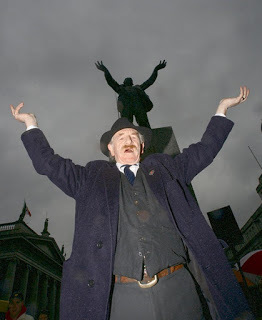
Jer as Big Jim Larkin I have been at too many funerals since Christmas. Ted says it’s because we are people of a certain age. Former Dundalk Sinn Féin Councillor Harry Todd, Arthur Mullen, Armagh City Sinn Féin activist Dympna McCague (Corrigan) and actor and trade union activist Jer O’Leary all passed. I never got to the funeral of David Cullinane’s mother Bernadette. Or H Block escapee Seamus McElwaine’s mother. And my friend Jane Crane didn’t have a funeral. Instead her ashes were scattered on Errigal. Great human beings all of them. I am blessed to have known them. My condolences and sympathies to all of their families. I was at Jer O’Leary’s funeral along with Mary Lou McDonald, Micheál Mac Donncha, Lucilita Breathnach and many others from Sinn Féin. There were other political activists, people from theatre and cinema, trade unionists, friends and neighbours. Jer’s coffin was draped in the Starry Plough and the procession included some of his finest trade union banners. I have known Jeremiah ‘Jer’ O’Leary for decades. He was a big man. Big in body. Big in spirit. Big in voice. Most people have heard of Big Jim Larkin. His name is synonymous with that of James Connolly and the 1913 Dublin Lock-out. Jer’s performance as Larkin brought the character and strength and voice of Larkin alive to generations who never knew him. In countless pageants, Sinn Féin Ard Fheiseanna, community events and plays Jer revelled in the part of Larkin. With arms outstretched, head raised and voice booming he was the embodiment of Big Jim.
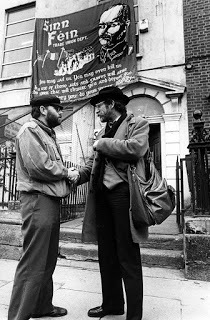 Tom Hartley receiving Trade Union Banner form Jer 1986
Jer was a proud north-side Dubliner. He grew up in Drumcondra. According to his sister Margaret; “It was a great neighbourhood to grow up in, with dozens of local kids around our own age, and after school and during the holidays with everybody playing together on the local roads and on the railway line when we could get away with it. Football featured early in Jer’s life with daily battles on the road with teams from adjacent districts.” For years he supported Drumcondra FC but when that folded he began to support Bohemian FC which he continued to do until his death. Jer also supported Glasgow Celtic.In Dublin, and Belfast the weekend was also cinema time. TVs were a rare item in working class homes. Jer loved westerns and comics. He left school at 14 and by 16 was working in Birmingham helping to build the Bull Ring project. In the 1967 he joined the IRA. The story is told that he was one of the sentries for the IRA Army Convention which was held in December 1969 and which saw the IRA split into the Official and Provisional groups. Jer was an Official and had the dubious distinction of being the first person convicted in the South for IRA activity after 1969. He was imprisoned in Mountjoy. He later left the Officials and joined the Communist Party of Ireland but he remained friends with all of his former republican comrades from the 60’s.Jer was a strong trade unionist. He was a member of the ITGWU and later Equity and SIPTU Health. He took a particular interest in international struggles and was a prominent supporter of the campaign to end apartheid in South Africa. As a trade unionist he put the artistic skills he honed in Mountjoy Prison to great use designing and making banners for trade unions. He was always proud when he saw his banners on protest marches and demonstrations. It was in 1975 in the Non-Stop Connolly Show in Liberty Hall that Jer first played the role of Big Jim Larkin. Later he attracted wider public attention when he took part in Peter and Jim Sheridan’s production of James Plunkett’s The Risen People. His radical republican politics were always very close to his heart. So close that on one memorable occasion at the end of the performance of The Marat Sade – a Marxist view of the French Revolution – in an unrehearsed speech to the packed audience he proclaimed that the men imprisoned for the Sallins’ train robbery were innocent.
Tom Hartley receiving Trade Union Banner form Jer 1986
Jer was a proud north-side Dubliner. He grew up in Drumcondra. According to his sister Margaret; “It was a great neighbourhood to grow up in, with dozens of local kids around our own age, and after school and during the holidays with everybody playing together on the local roads and on the railway line when we could get away with it. Football featured early in Jer’s life with daily battles on the road with teams from adjacent districts.” For years he supported Drumcondra FC but when that folded he began to support Bohemian FC which he continued to do until his death. Jer also supported Glasgow Celtic.In Dublin, and Belfast the weekend was also cinema time. TVs were a rare item in working class homes. Jer loved westerns and comics. He left school at 14 and by 16 was working in Birmingham helping to build the Bull Ring project. In the 1967 he joined the IRA. The story is told that he was one of the sentries for the IRA Army Convention which was held in December 1969 and which saw the IRA split into the Official and Provisional groups. Jer was an Official and had the dubious distinction of being the first person convicted in the South for IRA activity after 1969. He was imprisoned in Mountjoy. He later left the Officials and joined the Communist Party of Ireland but he remained friends with all of his former republican comrades from the 60’s.Jer was a strong trade unionist. He was a member of the ITGWU and later Equity and SIPTU Health. He took a particular interest in international struggles and was a prominent supporter of the campaign to end apartheid in South Africa. As a trade unionist he put the artistic skills he honed in Mountjoy Prison to great use designing and making banners for trade unions. He was always proud when he saw his banners on protest marches and demonstrations. It was in 1975 in the Non-Stop Connolly Show in Liberty Hall that Jer first played the role of Big Jim Larkin. Later he attracted wider public attention when he took part in Peter and Jim Sheridan’s production of James Plunkett’s The Risen People. His radical republican politics were always very close to his heart. So close that on one memorable occasion at the end of the performance of The Marat Sade – a Marxist view of the French Revolution – in an unrehearsed speech to the packed audience he proclaimed that the men imprisoned for the Sallins’ train robbery were innocent.
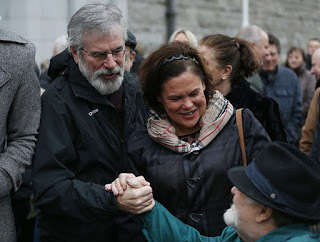 At Jer's funeral
Jer had parts in 42 films, including Braveheart, My Left Foot, In the Name of the Father, Michael Collins, and the Field. He also acted in Game of Thrones. But it as Big Jim Larkin that he will be most fondly remembered.Jer O’Learly understood the power of language, of words. And he could deliver a speech like no other. At a Sinn Féin event in the Mansion House he was Big Jim Larkin. In Glasnevin Cemetery in 2017 he read the 1916 Proclamation. Over the years he has spoken at countless republican events often as Larkin, sometimes as himself and occasionally as James Connolly delivering his final statement to the Court Martial. In 1998 the Sinn Féin Ard Fheis celebrated the 200th anniversary of the United Irish Society. Jer was Wolfe Tone. He was accompanied by a group of pike men and women, including his son Diarmuid. Later that year Diarmuid died in a fire in Glasgow. Jer and Diarmuid had separately travelled to Glasgow for a Celtic match and bumped into each other briefly afterward. Diarmuid died later that day in a fire. It was a terrible loss for Jer, and the rest of the family. Subsequently Jer’s partner Eithne died in December 2017. It was a loss he never properly recovered from.Finally, in October 2017 he attended Spraoi ar an Sráid, the Moore Street Party that Micheál Mac Donncha organised as Ardmhéara of Dublin. The event was to support of the campaign to save the 1916 battlefield site. Once again he passionately proclaimed the words of the French revolutionary Camile Desmoulins, as quoted by Connolly and Larkin:"The great are not great. The great only appear great because we are on our knees. Let us arise!" Ní bheidh a leithéid arís ann agus mar a dúirt Jer féin go minic 'An Phoblacht abú.'"
At Jer's funeral
Jer had parts in 42 films, including Braveheart, My Left Foot, In the Name of the Father, Michael Collins, and the Field. He also acted in Game of Thrones. But it as Big Jim Larkin that he will be most fondly remembered.Jer O’Learly understood the power of language, of words. And he could deliver a speech like no other. At a Sinn Féin event in the Mansion House he was Big Jim Larkin. In Glasnevin Cemetery in 2017 he read the 1916 Proclamation. Over the years he has spoken at countless republican events often as Larkin, sometimes as himself and occasionally as James Connolly delivering his final statement to the Court Martial. In 1998 the Sinn Féin Ard Fheis celebrated the 200th anniversary of the United Irish Society. Jer was Wolfe Tone. He was accompanied by a group of pike men and women, including his son Diarmuid. Later that year Diarmuid died in a fire in Glasgow. Jer and Diarmuid had separately travelled to Glasgow for a Celtic match and bumped into each other briefly afterward. Diarmuid died later that day in a fire. It was a terrible loss for Jer, and the rest of the family. Subsequently Jer’s partner Eithne died in December 2017. It was a loss he never properly recovered from.Finally, in October 2017 he attended Spraoi ar an Sráid, the Moore Street Party that Micheál Mac Donncha organised as Ardmhéara of Dublin. The event was to support of the campaign to save the 1916 battlefield site. Once again he passionately proclaimed the words of the French revolutionary Camile Desmoulins, as quoted by Connolly and Larkin:"The great are not great. The great only appear great because we are on our knees. Let us arise!" Ní bheidh a leithéid arís ann agus mar a dúirt Jer féin go minic 'An Phoblacht abú.'"
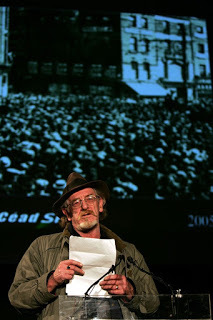
Published on January 18, 2019 09:30
January 12, 2019
A challenging year ahead
2019 is already promising to be one of those year’s historians and pundits love to label ‘seminal’ or ‘watershed’. There are big issues and big challenges coming down the tracks which will potentially shape life on our island for years to come.The most immediate and obvious is Brexit. England and Wales voted to leave the European Union in 2016. The North and Scotland voted to remain. Those democratic votes have been set aside as the Brexiteers rush lemming-like toward the cliff. British politics are in chaos. A deeply divided Conservative party is being propped up by the DUP. Theresa May says that she is trying to chart a course that will avoid a hard border on the island of Ireland and a calamitous economic melt-down of the British economy.According to a poll of Conservative Party members published this week there is a large majority – 64% - in favour of a no-deal Brexit. Only 29% would support the withdrawal agreement Theresa May struck with the EU. According to the Economic and Social Research Council poll the “Tory rank and file, it seems, are convinced that no deal is better than May’s deal.”Many are also vehemently opposed to the backstop agreement.No one on this island will be surprised by this or by Tory opposition to the backstop. In recent months English jingoism toward Ireland has been strident. Last month a British government report suggested that the South could face food shortages if there was a no-deal Brexit. Former British Conservative Minister, Priti Patel jumped on this claim and said that the British government should exploit potential food shortages in Ireland in its negotiations with the EU. There was widespread outrage with many people reminding her of the despicable role of Britain in the Great Hunger.Comedian Patrick Kielty scathingly responded with; “Quick one for Priti Patel before she reruns the Irish Famine -
Ireland is a major importer of food from the UK.
The UK is a major importer of food from the EU.
Ireland is a member of, guess what? The EU.
If shit was wit she’d be constipated”.Another senior Tory and former Minister commenting on Brexit told the BBC that “we simply cannot allow the Irish to treat us like this … This simply cannot stand. The Irish really should know their place”.And this week Jacob Rees Mogg tried to shift responsibility for Brexit, and any damaging effects, away from the Conservatives and onto the Irish government. He tweeted last Thursday: “If we leave without a deal the main culprit will be the obdurate Irish government’s threats about the phantom border issue.”Next week the British Parliament will vote on Theresa May’s withdrawal agreement. With up to 40 Conservative MPs and the DUP saying NO – and the British Labour Party seeking an election and opposing the withdrawal agreement – it seems very likely May will lose. She has thus far dismissed suggestions that she should extend Article 50 or withdraw it entirely and then apply again to buy more time.Whatever decision the British government and Parliament take the shambles that is Brexit will stagger on into the months and probably years ahead. The multiple dangers it presents for citizens on this island - especially those living in the north – to the Good Friday Agreement, to human rights protections and to the two economies on the island, are enormous. In this Brexit context – with the report into the RHI scandal to be published – and the DUP stubbornly refusing to properly address the key issues of rights which collapsed the institutions, the task of finding a resolution to the current impasse remains hugely problematic.In addition, there are a range of other challenges in 2019. In May there will be a referendum in the South on the right of Irish citizens in the North and in the diaspora to vote in Presidential elections. This is an important opportunity that must be grasped. On the same day May 24th there will also be local government elections north and south. In the north we don’t know yet if the SDLP will stand candidates under its own party name or if Fianna Fáil will have gobbled it up in the much speculated merger. The SDLP has been in decline for some years now. The loss of all its Westminster seats in 2017 was a huge blow. It has scrambled to make itself relevant. The way its leadership has handle all this merger issue must be deeply upsetting to SDLP members.In the past the SDLP was always close to Fianna Fáil, Fine Gael and the Irish Labour Party. These parties regularly campaigned in the North in support of SDLP candidates. However, the decisive shift by northern voters away from the SDLP and Westminster has clearly forced a rethink within the SDLP and a realisation that the future of politics for Irish political parties is on the island of Ireland. Hence the conversations with Fianna Fáil. That party, and most especially its leader Micheál Martin, is obsessed with Sinn Féin and its growth in the South. He has prevaricated for years now on organising Fianna Fáil in the North. The issue of successful SDLP/Fianna Fáil Westminster candidates swearing an oath to an English Monarch is one which we will all watch with interest given Fianna Fail’s claim to be The Republican Party.There is also a question about whether Fianna Fáil, if it had a mandate in the North, would power share with Sinn Féin. Micheál Martin has ruled out going into government with Sinn Féin in the South because he claims the party is not fit for government. So what about the North?Other substantial issues, including legacy, housing and homelessness, the state of the health services, will also top the political agendas north and south in 2019.Internationally, climate change is the single biggest challenge facing humanity this century. I will write more on this soon. The crisis in the Middle East, and especially the appalling treatment of the Palestinian people, will sadly persist in casting a shadow over an international community that has shamefully failed to uphold international law and confront Israel’s apartheid policies. These matters and others will ensure that this will be a testing and busy political year.2019 here we come! Bliain Úr faoi mhaise daoibhse go leir.
Published on January 12, 2019 02:37
January 6, 2019
Building a shared Ireland from the Vision of the First Dáil
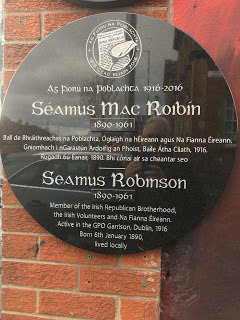
Mention the Sinn Féin office on the Falls Road, at its junction with Sevastopol Street, and most people will immediately associate it with the iconic gable wall mural of Bobby Sands that has been there for years. Along the front of the building are a number of plaques relating to Sinn Fein Vice President Maire Drumm and former H-Block hunger striker Pat McGeown, as well as of Pat McBride, Paddy Loughran and Michael O’Dwyer who were shot dead by an RUC officer in the building in February 1992.Less well known and just around the corner, alongside Bobby’s mural, there is a small round black plaque dedicated to Seamus Robinson. Robinson was born in Sevastopol Street in 1890. His story as a founding member of Na Fianna Éireann, a leading figure in the Irish Republican Brotherhood, and his role in the Easter Rising of 1916, as a political prisoner, and later in the IRA, Sinn Féin and in Fianna Fáil, are not as well-known as that of many others. Nor too is his central role in the opening shots of the Tan War during the Soloheadbeg ambush on 21 January 1919.At that time Seamus Robinson was the O.C (Officer Commanding) the Third Tipperary Brigade. Along with Séan Treacy and Dan Breen they ambushed a shipment of one hundred and sixty pounds of gelignite that was being taken to the quarry at Soloheadbeg. According to historical accounts the event lasted only a few minutes. When it was over the two RIC (Royal Irish Constabulary) policemen, Constables MacDonnell and O’Connell, who were guarding the shipment of explosives, were dead. These were the first shots and the first fatalities in the Tan War and subsequent Civil War which consumed Ireland over the next five years.On the same day, and almost 200 kilometres to the north east in Dublin, the First Dáil Éireann was meeting. The 21s January 1919 saw all of those Sinn Féin TDs elected in the general election of December 1918, and who were not in a British prison, gather in the Mansion House to establish the first ever democratically elected Parliament in Ireland. It was a historic day. There were huge celebrations in Dublin.The First Dáil was the promise of 1916 taking shape. It was the moment when the Irish people democratically asserted their desire for national freedom and independence from the British Empire. It witnessed the publication of the Democratic Programme of the First Dáil. That extraordinary document envisaged a new Republic, a new Ireland, in which the people are citizens, not subjects; where there is equality, not elitism; and where there is unity, not partition and division.Reflecting the language of the Proclamation of 1916 the Democratic Programme declared “the right of the people of Ireland to the ownership of Ireland, and to the unfettered control of Irish destinies to be indefeasible …” It also called for,“our country to be ruled in accordance with the principles of Liberty, Equality, and Justice for all …”The Democratic Programme embraced equality and the belief that citizens have rights and that the state has a responsibility to deliver and defend those rights.The Programme called on the Government of the Republic “to make provision for the physical, mental and spiritual well-being of the children, to secure that no child shall suffer hunger or cold from lack of food, clothing, or shelter, but that all shall be provided with the means and facilities requisite for their proper education and training as Citizens …” And to “safeguard the health of the people.”100 years later the two states created by partition have failed to meet these democratic objectives. Sinn Féin believes that only through Irish unity can the schisms and divisions, and decades of conflict and insecurity, be set aside. As part of our celebration of the centenary of events that commenced six years ago with the signing in 1912 of the Solemn League and Covenant, and witnessed the creation of the Citizen Army, the Irish Volunteers, Cumann na Mbán, the 1916 Easter Rising, and much more, Sinn Féin will be holding a national meeting in the Mansion House on January 12thto celebrate the remarkable events of January 1919. Why not join us? In a few short months on 24 May voters in the 26 counties will have the opportunity to build on the events of 1919 by voting to allow Irish citizens living outside the state a vote in future Presidential elections. Sinn Féin will be campaigning in support of this vote. In the meantime those MPs who want to, should have speaking rights in the Dáil, without voting rights, as former Taoiseach Bertie Ahern promised over twenty years ago. The Southern parties should also, as they are constitutionally obliged, plan for a new shared Ireland. They could do this by the Oireachtas or the Government convening an all island and Diaspora wide consultation process, including consultative conventions, to discuss how a shared Ireland can be built in an inclusive way. In keeping with the Good Friday Agreement this involves a referendum on Irish unity. The Taoiseach gas a duty to plan for this now.
Published on January 06, 2019 13:50
December 28, 2018
Nollag Shona Daoibhse agus Athbhliain Faoi Mhaise
Nollag Shona Daoibhse agus Athbhliain Faoi Mhaise
I like Christmas. I always have. To be clear I don’t like the mad stressed out state that some people are driven to as the commercial Gods pursue profit no matter what the cost is for working people. Or the poor. Or the rest of us. I don’t like the increasing secular nature of the holiday. I am offended when Christ is taken out off Christ-Mas. I detest Xmas.
I like the Christmas story. Yes it has more holes in it than a colander but we shouldn’t let facts get in the way of a good story. Christmas is a morality tale. We are all familiar with it. A poor couple, the woman Mary heavily pregnant and her husband Joseph a carpenter, making their way home for the census. They have no where to stay for the night. They end up in a stable in Bethlehem. After being denied accommodation at an inn they are directed for shelter to where animals are bedded down for the night.
I was in Bethlehem once. The stable where It is said Mary and Joseph took shelter, is actually a cave. When I was there Bethlehem was occupied by Israeli soldiers. At the time Joseph and Mary were there Bethlehem was also under military occupation. At that time the soldiers were Romans.
So that is where Jesus was born. Not in a palace. Not in a huge mansion. Not even in a house. Nope. In a stable. A refugee. Not the blue eyed blond infant so beloved of western nativity scenes. More likely a dark eyed dark skinned baby like those little children we see on our television screens in troubled parts of the Middle East, in refugee camps or other parts of the developing world. The first humans to visit them were shepherds. Other poor people herding sheep on rocky hillsides. Oh and the three wise men. They called as well. Following a star in the sky they came to the stable. The way wise men do.
Poor Mary and Joseph. The Jewish people were waiting for a saviour to free them from Roman rule. Their baby was barely born and he was being proclaimed as The Saviour. The Christ. So they had to leave the stable and flee for fear the Romans would kill their baby. On the run with only a donkey for transport. The rest is history. But it’s a history which lives to this day.
The baby born in a stable spoke truth to power. He raged against the machine. His message was about love. He became a preacher, a teacher. His teaching were seen as a threat to the status quo. So he was executed by the system. Crucified. I don’t like that part of the story. But I do like the first part. The simplicity of it. It’s durability. It’s relevance today.
I like the customs associated with Christmas. Especially in Ireland. I especially like to light a little light in the window to guide poor travellers. I like the story of how the donkey - that most noble lowly animal- got a cross on its back because it carried Jesus. I love holly with bright red berries. I like carols. In Latin and Irish. In English also. Oiche Ciúin sung by the late Geordie Shannon’s choir in Long Kesh on Christmas Eve has its own acoustic. Even now in my musical memory.
I also like Santa Claus. Daddy Christmas. Daidí na Nollag. Not the portly guy in the Coca Cola advert. No. I like the real thing. I like how little children are in awe of him. How they write him letters. How he makes his way down the chimney, how Rudolf, one of his reindeers, had a red nose. How they pull his sled through the skies.
One Christmas one of the little people in my life was perched on Daidí na Nollag’s knee. We were in Conway Mill.
“What do you want for Christmas little girl?” He asked.
“A lap top”. She replied hopefully.
“Do you think I’m made of money” He chortled “Ho Ho Ho”.
I like that.
I like how we wish each other a happy Christmas. How we give and receive presents. So long as we don’t go over the top. In giving. Or in anticipation of receiving. I don’t like how Christmas can be a lonely place for some people. How the loneliness in their lives can come into even sharper relief.
If you are homeless, or estranged from your family or friends. If you are recently bereaved. In trouble. Worried. Suffering from addiction. Sick. If you have no money. Or not enough money. Christmas can be a drag. An unwelcome period of further isolation and desolation. Of quiet desperation.
Unless someone reaches out to you. With a kind word. With a wee bit of their time. A smile. An act of companionship. A wee gesture. An act of kindness. A wee present. A friendly action. A hug. So let’s have a great Christmas. Let’s make Christmas for everyone. Let’s keep it simple. Let’s not forget it’s about a little baby born in a stable.
Published on December 28, 2018 03:39
December 22, 2018
No place for partitionism
Re-enactments can be a powerful way of telling a story and reminding an audience of the role individuals, organisations or political movements have played in the history of a nation. Sometimes such enactments can take the form of plays or movies or television specials. Occasionally someone will go to the trouble of reproducing the events surrounding a historic moment in real time. Last week RTE undertook that task with its re-enactment of the general election of 1918.Studio presenters and outside broadcasts told the story of that defining moment in modern Irish history as if that election was taking place now with all the modern technology available to contemporary election coverage.It was a fascinating account of 14th December 1918 told with all of the excitement and drama we have come to expect from today’s elections. For the teacher interested in persuading her or his class of the importance of history, and in particular of that general election result, or for anyone interested Irish history, the RTE programme was a unique look back at that extraordinary general election. For those of you who didn’t see it click onto RTE’s website. It is available there at www.rte.ie/eile/election-1918/The 1918 election is remarkable for many reasons. For the first time men over the age of 21 could vote. However, women were not given the franchise on the same basis. Only women over the age of 30 who were property owners or the wives of property owners, or were university graduates could vote. Confusion over whether women could stand as candidates also meant that only a handful eventually stood. The first successful woman candidate was Countess Markievicz. In keeping with the abstentionist policy of Sinn Féin, Markievicz and her 72 male colleagues all refused to take the Oath of Allegiance to the English monarchy. The results of the election didn’t become public until December 28th. Three weeks later, on January 21st 1919, those Teachta Dalai not imprisoned by the British met in the Mansion House in Dublin and established the First Dáil – the first ever democratically elected Parliament of the Irish people.Countess Markievicz then became the first ever government Minister when she was appointed Minister for Labour.The 1918 election was a game changer in Irish history. It was the first and only time that the people of the island of Ireland voted together in an election. It was the work of the First Dáil and guerrilla war waged by the Irish Republican Army which forced the British to the negotiating table two years later. Regrettably the opportunity to establish the Republic envisaged in the Proclamation was thwarted in the negotiations that led to the Treaty. It was signed on 6 December 1921. The result was the imposition of partition, a two year bloody civil war, and the creation of two mean spirited deeply conservative states on the island. In the North the establishment of the Unionist dominated one party state with its sectarian policies and the application of structured political and religious discrimination in all areas of public life, including in employment, housing, investment, the law, policing, and education, created the foundation for decades of political instability and conflict.In the Southern state the counter-revolution saw the Anglo/Irish establishment replaced by a native establishment which frequently used the Republican rhetoric of the 1916 - 1921 period. Although its leaders often spoke in glowing terms of those past generations that had fought for independence and freedom, they ultimately did little to end the shame of partition.For the leaderships of Fianna Fáil, Fine Gael and Labour partitionism became instinctive. Political life in the 26 counties was dominated by Civil War politics and the rivalry between Fianna Fáil and Fine Gael. But as the immediate effects of the Civil War receded this rivalry turned out not to be about any ideological differences, especially around partition, but over who could wield the symbols of state and control the spoils of power. The current confidence and supply arrangement between Fianna Fáil and Fine Gael is especially relevant to this. What difference is there really between Fianna Fail and Fine Gael? Two conservative parties, each jockeying for domination, but with no ideological differences, no desire, and no concept of what they need to do, to achieve Irish unity.Watch their performances in the Dáil. Let Mary Lou or Pearse Doherty or any Sinn Féin TD dare talk about a referendum on Irish Unity or about the imperative of ending partition, and the vitriolic voices of opposition and condemnation echo across the chamber from the Fianna Fáil and Fine Gael benches.Partitionism is part and parcel of the politics and language of the establishment parties in the Dáil and Seanad. The word ‘Ireland’ is now used to denote just the 26 counties. Was it for this that the men and women of 1916 fought and died? Was it for this that the IRB and the United Irish Society with their clear objective of independence and freedom for Ireland, fight and die?A few years ago Rita O’Hare and Mary Lou McDonald attended the annual St. Patrick’s Day reception hosted by the Irish Embassy in Washington. On the stage – as a backdrop for the proceedings - was a map of Ireland. Mary Lou and Rita and some of the American guests were stunned to see that it was a map of the 26 counties. The North had disappeared. It was as if some huge monster had torn a chunk out of the island leaving behind this misshapen and deformed excuse for Ireland. It was as if the island of Ireland had never existed. The government is not alone in promoting Ireland in this way. In September 2017 there was outrage when RTE’s Late Late Show used a similarly mutilated map. RTE subsequently apologised. But that is not the end of the story. Frequently, when RTE is reporting on the weather the North once again disappears. The storms, rain, snow and sun all stop at the border. The North is either blank or non existent, as if it simply disappeared into the surrounding sea. The 1918 election was a victory for ordinary men and women. Almost one and a half million voted for the first time. They demonstrated by their overwhelming vote of confidence in Ireland that we could reimagine a future separate from Britain, and in which nationalist and unionist and republican could live together in harmony and peace on the basis of equality. We were no longer to be subjects of the British Crown but free citizens in a free democracy.Freedom, unity, citizenship, democracy, equality, parity of esteem, inclusiveness must be the principles that guide us in the time ahead. This month we celebrate the centenary of the 1918 election. Next month will be the centenary of the First Dáil. If we are to honour the memory and actions of those who made those momentous events possible; if we are to succeed in achieving a New Ireland, embracing all of those citizens who live on this island, there can be no place for or tolerance of partitionism.
Published on December 22, 2018 02:01
December 15, 2018
John Joe McGirl - An unrepentant Fenian
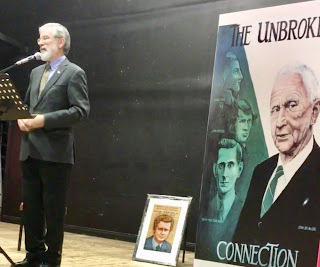
The rain wasn’t waiting to fall. It was bucketing, pelting, lashing and generally hammering down on the road to Ballinamore in County Leitrim on Saturday night. When we finally arrived, and despite the cold and the rain, the Ballinamore Community Centre was packed to overflowing. It was a wonderful testament to the love and affection which John Joe McGirl is still help by his local community thirty years after his death. I was there to talk about John Joe, his contribution and legacy to the struggle for freedom and independence.My first port of call before going to the Centre was to visit the McGirl family home and pay my respect to Mrs. Bridie McGirl. She and John Joe were married in 1951 and had five children Liam, Áine, Cait, Feargal and Nuala. Given the frequency of John Joe’s periods in prison Bridie did a great job of rearing the children. She will 91 on Christmas Eve – Lá breithe shona Bridie.As well as being Vice President of Sinn Féin, an former POW and a republican activist for decades, John Joe also had a long connection with Belfast. He had the distinction of being in two different prisons when both were set on fire by Republican POWs. The first time was in the notorious Curragh in December 1940 where he was savagely beaten. The second time was Long Kesh in 1974. John Joe had travelled to Belfast at Easter 1974 to give the Easter Commemoration speech. The Brits thought he was Seamus Twomey and he was arrested. When they discovered their mistake John Joe was sent to the internee end of the Long Kesh camp.
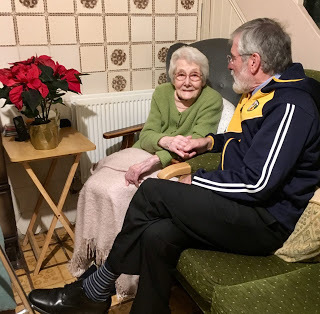
Mrs. McGirl 91 on Christmas Eve When he arrived all us internees thought – poor oul John Joe – we all felt so sorry for him. But there was no sadness or despair in John Joe. He had been down this road so many times before. Later in October that year the republican POWs burned Long Kesh to the ground. There was a fierce series of running battles through the night and the following morning in different parts of the camp between the Republican POWs and the British Army. In the midst of this John Joe was hit in the face by a rubber bullet. If my recollection is right his jaw was fractured. As flames licked around the watch-towers I made my way to John Joe and asked how he was. His response – “I’m alright as long as you people are alright”.Speaking later about his time in Long Kesh John Joe said: “I spent nine months there…I saw young men fight hand to hand with British soldiers. I know what it means to be kicked, beaten, gassed, made to sleep in a blanket under a sheet of iron in the month of October. I was glad to join this new generation in writing their chapter in the fight for independence. I am proud to say of them – that no generation has produced braver or better”.John Joe’s entire adult life was a reflection of the years of republican struggle through the 1930s, 40’s, 50’s, 60’s, 70’s and 80’s. Five decades of selfless commitment to the struggle for Irish freedom and independence. He was the ‘unbreakable Fenian’, the ‘gentle soldier’.John Joe never wavered in his commitment. He played a key role in all of the great decisions that republicans were to take in the following decades. He was there when all of the great efforts to reorganise and to mobilise and to advance the struggle for freedom were undertaken.I had the great honour and privilege to meet John Joe first in the late 1960s. I got the bus from Belfast to Enniskillen one Friday evening and hitch-hiked to Ballinamore. I slept in a field in my trusty sleeping bag and I landed in here on a Saturday morning. John Joe brought me to Sliabh an Iarainn, to Lough Allen and to Drumshambo. I remember the coal miners in Arigna where on strike and we attended one of their meetings. The year after that I spent a few weeks camping on the shores of Lough Allen outside Drumshambo.After the pogroms of 1969 against nationalist areas of Belfast John Joe was among those who took a stand in support of the nationalist people of the North. He threw his body and soul into providing support and help.Later during the 1981 hunger strike John Joe travelled the length and breadth of the state rallying support for the hunger strikers. In the June 1981 general election Ciaran Doherty and Paddy Agnew were elected as TDs. Joe McDonnell came close to taking a seat in Sligo Leitrim. Despite the risk of arrest John Joe attended his funeral in Belfast. He gave the oration at Joe’s graveside in Milltown. He said: “Joe McDonnell died rather than debase the cause he served, rather than live with the forced tag of criminality on him… We will build Joe McDonnell a memorial… that will be the freedom and the unity of the Irish people.”In 1986 John Joe seconded the motion calling for an end to the abstentionist policy towards Leinster House. As a former abstentionist TD it was a big decision for him to take. It was for him a necessary step if, in his words, “we are not going to hand down this struggle to another generation”.
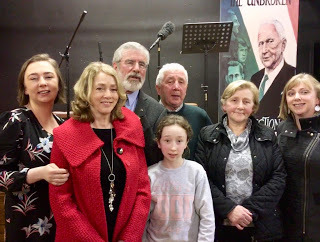
With some of John Joe's family Thirty years ago John Joe had been ill for a time and I called to see him and Mrs. McGirl. I was on my own. He asked me to take him to Garadice Lough. After I was fed and watered I drove him there. It was a bright sunny late summers day. John Joe sat with me by the lough. At one point he actually took off his shirt. I remember he was wearing a white simmet. He really enjoyed the sun on his bare arms and face. He knew he was dying.He said he was sorry he wouldn’t live to see Ireland united but he felt great progress had been made and that he was glad to be part of that. On the way back here to Ballinamore he said he had great confidence for the future.Martin McGuinness like me loved John Joe. In a tribute to him Martin described John Joe as a “progressive thinker, always prepared to consider, support and propose new ways for the Republican Movement to advance. He wasn’t prepared to stand still or hold to old outdated tactics which were incapable of developing the struggle on all fronts… He was an extraordinary man, an inspiration to everyone who knew him. We treasure his memory”.
Published on December 15, 2018 01:22
December 8, 2018
The Last Of The Summer Wine.
There were nine of them. Strung out in a staggered meandering column. Some were obviously walking wounded. They made their way slowly through the narrow hilly streets of the Mediterranean town, in the late Autumn sunshine. Every so often the more sprightly of these intrepid ramblers would stop until their less sprightly companeros caught up with the main group. Then off they wandered again. Chatting. Laughing. Complaining. Giggling. Singing.
They were all men. Of advanced ages. But they were progressive decent men. No need for gender disputes here. This was their little outing and they had travelled with the support, perhaps even in some cases the encouragement, of their partners. For the purposes of this little narrative they shall remain anonymous. Suffice to say they all know each other for a very long time. Their ages are from mid sixties to almost mis-seventies. They have been friends for at least forty years or so. Some - well one - even claims to be a fifty year man. That they remain friends is hardly surprising given what they had gone through. Or put others through. Including each other. But as The Fifty Years Man once proclaimed ‘ You don’t have to like your friends to be friends with them.’
Their journeys through life have meandered through decades of political struggle. Street activism. Funerals. Set backs. Advances. Death. Interrogation centres. Internment. Non Jury Courts. A Prison Ship. Long Kesh. The Crum. Magilligan. The H Blocks. Some even meandered into USA custody. From war through a peace process. And they survived it all.
So here they were on a social ramble in a Mediterranean town. The last time they did this was about ten years ago. An American amigo had travelled to be with them. On that occasion they sat on a wall to be photographed. The Quiet American remarked as the camera shutter clicked, “ I wonder how many of us will be around in ten years time?”
Well most of them were. Including The Quiet American who traveled again. But there was one notable absentee. He was the centre of their first outing, a small chap who regaled the rest of them and entertained the company and everyone else. Then when he got home he went and died. That also put him at the centre of this excursion. When ever our wanderers rambled past a spot where The Departed One had ceili-ed they paused for a quiet moment to retell the tale and to reflect on his great exploits. There was even some talk of erecting a discreet little plaque at a particular corner where he and The Very Hospitable Comrade had demonstrated to the rush hour commuters in this Mediterranean town how two Irishmen abroad could make a show of themselves.
So on this trip when they sat on a wall to be photographed they left a little space for The Departed One. The Fifty Year Man speculated how long it would be before there were more spaces than faces.
“The way you lot are getting on I’ll be here on my own in another ten years.” He observed.
“G’wan ya Glyp” The Very Hospitable Comrade berated him.
It was then The Caustic One spoke up.
“I propose we do this in five years time just to give some of youse a chance”.
Everyone agreed. Even The Man of No Property, recently dispossessed, thought that a very good idea. There was tentative talk of a monthly subscription, non returnable if death intervened. The Gentle Gaeilgeoir dissented.
“What about oration rights?” He asked.
I mBearla for the sake of the daoine gan Gaeilge. There was no agreement on who would orate for who. Or in what teanga.
And so they rambled on. That was one of their purposes. Rambling. Eating. And because all were fond of a wee drink they occasionally had that as well. Their main objective was to have adventures. To have fun. And so they did. Especially The Very Fine Baritone. So the banter, the slagging and comradarie followed them like happy puppy hounds following their masters.
The mood was infectious. So was the sunshine. Efforts to ban talk of politics, religion or Antrim GAA or current affairs fell at the first fence. At the very first round in fact. The craic was ninety. Loud too sometimes but always, or mostly, good humored though that was not always the intention. But that’s how it turned out. A laugh a minute. Even The One With The Awful Cough rose from his sick bed to join in. Only to be blamed for passing the cough on to The Gentle Pescatarian.
So for six days they regaled, insulted and laughed at themselves. And on the seventh day they came home.
The Very Fine Baritone and The Fifty Years Man rose to their feet at the last supper in the little Mediterranean Greasy Joe’s where they had mustered to bid The Quiet American Slán.
“Oh of all the money that e’er I spent
I spent it in good company
And of all the harm that ever I did
Alas it was to none but me” they sang.
The Very Hospitable Comrade was very moved.
“I want youse to sing that at my funeral”. He mumbled.
And that’s how their trip abroad ended. With a fine song. Sung by fine singers. And a parting glass.
“And all I’ve done for want of wit
To memory now I can’t recall
So fill to me a parting glass
Good night and joy be with you all.”
See youse all in five years comrades. Subject to annual medical checks. And Brexit.
Published on December 08, 2018 08:19
Gerry Adams's Blog
- Gerry Adams's profile
- 29 followers
Gerry Adams isn't a Goodreads Author
(yet),
but they
do have a blog,
so here are some recent posts imported from
their feed.



